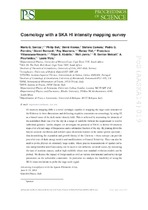Cosmology with a SKA HI intensity mapping survey

View/
Date
2014Author
Santos, Mario G.
Bull, Philip
Alonso, David
Camera, Stefano
Ferreira, Pedro G.
Bernardi, Gianni
Maartens, Roy
Viel, Matteo
Villaescusa-Navarro, Francisco
Abdalla, Filipe B.
Jarvis, Matt
Metcalf, R. Benton
Pourtsidou, A.
Wolz, Laura
Metadata
Show full item recordAbstract
HI intensity mapping (IM) is a novel technique capable of mapping the large-scale structure of
the Universe in three dimensions and delivering exquisite constraints on cosmology, by using HI
as a biased tracer of the dark matter density field. This is achieved by measuring the intensity of
the redshifted 21cm line over the sky in a range of redshifts without the requirement to resolve
individual galaxies. In this chapter, we investigate the potential of SKA1 to deliver HI intensity
maps over a broad range of frequencies and a substantial fraction of the sky. By pinning down the
baryon acoustic oscillation and redshift space distortion features in the matter power spectrum –
thus determining the expansion and growth history of the Universe – these surveys can provide
powerful tests of dark energy models and modifications to General Relativity. They can also be
used to probe physics on extremely large scales, where precise measurements of spatial curvature
and primordial non-Gaussianity can be used to test inflation; on small scales, by measuring
the sum of neutrino masses; and at high redshifts where non-standard evolution models can be
probed. We discuss the impact of foregrounds as well as various instrumental and survey design
parameters on the achievable constraints. In particular we analyse the feasibility of using the
SKA1 autocorrelations to probe the large-scale signal.
